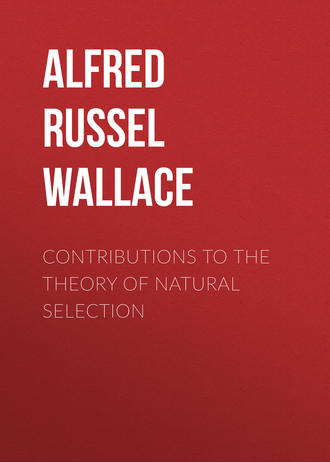 полная версия
полная версияContributions to the Theory of Natural Selection
We have every reason to believe, then, that man may have existed and may continue to exist, through a series of geological periods which shall see all other forms of animal life again and again changed; while he himself remains unchanged, except in the two particulars already specified—the head and face, as immediately connected with the organ of the mind and as being the medium of expressing the most refined emotions of his nature,—and to a slight extent in colour, hair, and proportions, so far as they are correlated with constitutional resistance to disease.
Summary
Briefly to recapitulate the argument;—in two distinct ways has man escaped the influence of those laws which have produced unceasing change in the animal world. 1. By his superior intellect he is enabled to provide himself with clothing and weapons, and by cultivating the soil to obtain a constant supply of congenial food. This renders it unnecessary for his body, like those of the lower animals, to be modified in accordance with changing conditions—to gain a warmer natural covering, to acquire more powerful teeth or claws, or to become adapted to obtain and digest new kinds of food, as circumstances may require. 2. By his superior sympathetic and moral feelings, he becomes fitted for the social state; he ceases to plunder the weak and helpless of his tribe; he shares the game which he has caught with less active or less fortunate hunters, or exchanges it for weapons which even the weak or the deformed can fashion; he saves the sick and wounded from death; and thus the power which leads to the rigid destruction of all animals who cannot in every respect help themselves, is prevented from acting on him.
This power is “natural selection;” and, as by no other means can it be shown, that individual variations can ever become accumulated and rendered permanent so as to form well-marked races, it follows that the differences which now separate mankind from other animals, must have been produced before he became possessed of a human intellect or human sympathies. This view also renders possible, or even requires, the existence of man at a comparatively remote geological epoch. For, during the long periods in which other animals have been undergoing modification in their whole structure, to such an amount as to constitute distinct genera and families, man’s body will have remained generically, or even specifically, the same, while his head and brain alone will have undergone modification equal to theirs. We can thus understand how it is that, judging from the head and brain, Professor Owen places man in a distinct sub-class of mammalia, while as regards the bony structure of his body, there is the closest anatomical resemblance to the anthropoid apes, “every tooth, every bone, strictly homologous—which makes the determination of the difference between Homo and Pithecus the anatomist’s difficulty.” The present theory fully recognises and accounts for these facts; and we may perhaps claim as corroborative of its truth, that it neither requires us to depreciate the intellectual chasm which separates man from the apes, nor refuses full recognition of the striking resemblances to them, which exist in other parts of his structure.
Conclusion
In concluding this brief sketch of a great subject, I would point out its bearing upon the future of the human race. If my conclusions are just, it must inevitably follow that the higher—the more intellectual and moral—must displace the lower and more degraded races; and the power of “natural selection,” still acting on his mental organization, must ever lead to the more perfect adaptation of man’s higher faculties to the conditions of surrounding nature, and to the exigencies of the social state. While his external form will probably ever remain unchanged, except in the development of that perfect beauty which results from a healthy and well organized body, refined and ennobled by the highest intellectual faculties and sympathetic emotions, his mental constitution may continue to advance and improve, till the world is again inhabited by a single nearly homogeneous race, no individual of which will be inferior to the noblest specimens of existing humanity.
Our progress towards such a result is very slow, but it still seems to be a progress. We are just now living at an abnormal period of the world’s history, owing to the marvellous developments and vast practical results of science, having been given to societies too low morally and intellectually, to know how to make the best use of them, and to whom they have consequently been curses as well as blessings. Among civilized nations at the present day, it does not seem possible for natural selection to act in any way, so as to secure the permanent advancement of morality and intelligence; for it is indisputably the mediocre, if not the low, both as regards morality and intelligence, who succeed best in life and multiply fastest. Yet there is undoubtedly an advance—on the whole a steady and a permanent one—both in the influence on public opinion of a high morality, and in the general desire for intellectual elevation; and as I cannot impute this in any way to “survival of the fittest,” I am forced to conclude that it is due, to the inherent progressive power of those glorious qualities which raise us so immeasurably above our fellow animals, and at the same time afford us the surest proof that there are other and higher existences than ourselves, from whom these qualities may have been derived, and towards whom we may be ever tending.
X.
THE LIMITS OF NATURAL SELECTION AS APPLIED TO MAN
Throughout this volume I have endeavoured to show, that the known laws of variation, multiplication, and heredity, resulting in a “struggle for existence” and the “survival of the fittest,” have probably sufficed to produce all the varieties of structure, all the wonderful adaptations, all the beauty of form and of colour, that we see in the animal and vegetable kingdoms. To the best of my ability I have answered the most obvious and the most often repeated objections to this theory, and have, I hope, added to its general strength, by showing how colour—one of the strongholds of the advocates of special creation—may be, in almost all its modifications, accounted for by the combined influence of sexual selection and the need of protection. I have also endeavoured to show, how the same power which has modified animals has acted on man; and have, I believe, proved that, as soon as the human intellect became developed above a certain low stage, man’s body would cease to be materially affected by natural selection, because the development of his mental faculties would render important modifications of its form and structure unnecessary. It will, therefore, probably excite some surprise among my readers, to find that I do not consider that all nature can be explained on the principles of which I am so ardent an advocate; and that I am now myself going to state objections, and to place limits, to the power of “natural selection.” I believe, however, that there are such limits; and that just as surely as we can trace the action of natural laws in the development of organic forms, and can clearly conceive that fuller knowledge would enable us to follow step by step the whole process of that development, so surely can we trace the action of some unknown higher law, beyond and independent of all those laws of which we have any knowledge. We can trace this action more or less distinctly in many phenomena, the two most important of which are—the origin of sensation or consciousness, and the development of man from the lower animals. I shall first consider the latter difficulty as more immediately connected with the subjects discussed in this volume.
What Natural Selection can Not do
In considering the question of the development of man by known natural laws, we must ever bear in mind the first principle of “natural selection,” no less than of the general theory of evolution, that all changes of form or structure, all increase in the size of an organ or in its complexity, all greater specialization or physiological division of labour, can only be brought about, in as much as it is for the good of the being so modified. Mr. Darwin himself has taken care to impress upon us, that “natural selection” has no power to produce absolute perfection but only relative perfection, no power to advance any being much beyond his follow beings, but only just so much beyond them as to enable it to survive them in the struggle for existence. Still less has it any power to produce modifications which are in any degree injurious to its possessor, and Mr. Darwin frequently uses the strong expression, that a single case of this kind would be fatal to his theory. If, therefore, we find in man any characters, which all the evidence we can obtain goes to show would have been actually injurious to him on their first appearance, they could not possibly have been produced by natural selection. Neither could any specially developed organ have been so produced if it had been merely useless to him, or if its use were not proportionate to its degree of development. Such cases as these would prove, that some other law, or some other power, than “natural selection” had been at work. But if, further, we could see that these very modifications, though hurtful or useless at the time when they first appeared, became in the highest degree useful at a much later period, and are now essential to the full moral and intellectual development of human nature, we should then infer the action of mind, foreseeing the future and preparing for it, just as surely as we do, when we see the breeder set himself to work with the determination to produce a definite improvement in some cultivated plant or domestic animal. I would further remark that this enquiry is as thoroughly scientific and legitimate as that into the origin of species itself. It is an attempt to solve the inverse problem, to deduce the existence of a new power of a definite character, in order to account for facts which according to the theory of natural selection ought not to happen. Such problems are well known to science, and the search after their solution has often led to the most brilliant results. In the case of man, there are facts of the nature above alluded to, and in calling attention to them, and in inferring a cause for them, I believe that I am as strictly within the bounds of scientific investigation as I have been in any other portion of my work.
The Brain of the Savage shown to be Larger than he Needs it to be
Size of Brain an important Element of Mental Power.—The brain is universally admitted to be the organ of the mind; and it is almost as universally admitted, that size of brain is one of the most important of the elements which determine mental power or capacity. There seems to be no doubt that brains differ considerably in quality, as indicated by greater or less complexity of the convolutions, quantity of grey matter, and perhaps unknown peculiarities of organization; but this difference of quality seems merely to increase or diminish the influence of quantity, not to neutralize it. Thus, all the most eminent modern writers see an intimate connection between the diminished size of the brain in the lower races of mankind, and their intellectual inferiority. The collections of Dr. J. B. Davis and Dr. Morton give the following as the average internal capacity of the cranium in the chief races:—Teutonic family, 94 cubic inches; Esquimaux, 91 cubic inches; Negroes, 85 cubic inches; Australians and Tasmanians, 82 cubic inches; Bushmen, 77 cubic inches. These last numbers, however, are deduced from comparatively few specimens, and may be below the average, just as a small number of Finns and Cossacks give 98 cubic inches, or considerably more than that of the German races. It is evident, therefore, that the absolute bulk of the brain is not necessarily much less in savage than in civilised man, for Esquimaux skulls are known with a capacity of 113 inches, or hardly less than the largest among Europeans. But what is still more extraordinary, the few remains yet known of pre-historic man do not indicate any material diminution in the size of the brain case. A Swiss skull of the stone age, found in the lake dwelling of Meilen, corresponded exactly to that of a Swiss youth of the present day. The celebrated Neanderthal skull had a larger circumference than the average, and its capacity, indicating actual mass of brain, is estimated to have been not less than 75 cubic inches, or nearly the average of existing Australian crania. The Engis skull, perhaps the oldest known, and which, according to Sir John Lubbock, “there seems no doubt was really contemporary with the mammoth and the cave bear,” is yet, according to Professor Huxley, “a fair average skull, which might have belonged to a philosopher, or might have contained the thoughtless brains of a savage.” Of the cave men of Les Eyzies, who were undoubtedly contemporary with the reindeer in the South of France, Professor Paul Broca says (in a paper read before the Congress of Pre-historic Archæology in 1868)—“The great capacity of the brain, the development of the frontal region, the fine elliptical form of the anterior part of the profile of the skull, are incontestible characteristics of superiority, such as we are accustomed to meet with in civilised races;” yet the great breadth of the face, the enormous development of the ascending ramus of the lower jaw, the extent and roughness of the surfaces for the attachment of the muscles, especially of the masticators, and the extraordinary development of the ridge of the femur, indicate enormous muscular power, and the habits of a savage and brutal race.
These facts might almost make us doubt whether the size of the brain is in any direct way an index of mental power, had we not the most conclusive evidence that it is so, in the fact that, whenever an adult male European has a skull less than nineteen inches in circumference, or has less than sixty-five cubic inches of brain, he is invariably idiotic. When we join with this the equally undisputed fact, that great men—those who combine acute perception with great reflective power, strong passions, and general energy of character, such as Napoleon, Cuvier, and O’Connell, have always heads far above the average size, we must feel satisfied that volume of brain is one, and perhaps the most important, measure of intellect; and this being the case, we cannot fail to be struck with the apparent anomaly, that many of the lowest savages should have as much brains as average Europeans. The idea is suggested of a surplusage of power; of an instrument beyond the needs of its possessor.
Comparison of the Brains of Man and of Anthropoid Apes.—In order to discover if there is any foundation for this notion, let us compare the brain of man with that of animals. The adult male Orang-utan is quite as bulky as a small sized man, while the Gorilla is considerably above the average size of man, as estimated by bulk and weight; yet the former has a brain of only 28 cubic inches, the latter, one of 30, or, in the largest specimen yet known, of 34½ cubic inches. We have seen that the average cranial capacity of the lowest savages is probably not less than five-sixths of that of the highest civilized races, while the brain of the anthropoid apes scarcely amounts to one-third of that of man, in both cases taking the average; or the proportions may be more clearly represented by the following figures—anthropoid apes, 10; savages, 26; civilized man, 32. But do these figures at all approximately represent the relative intellect of the three groups? Is the savage really no farther removed from the philosopher, and so much removed from the ape, as these figures would indicate? In considering this question, we must not forget that the heads of savages vary in size, almost as much as those of civilized Europeans. Thus, while the largest Teutonic skull in Dr. Davis’ collection is 112.4 cubic inches, there is an Araucanian of 115.5, an Esquimaux of 113.1, a Marquesan of 11O.6, a Negro of 105.8, and even an Australian of 104.5 cubic inches. We may, therefore, fairly compare the savage with the highest European on the one side, and with the Orang, Chimpanzee, or Gorilla, on the other, and see whether there is any relative proportion between brain and intellect.
Range of intellectual power in Man.—First, let us consider what this wonderful instrument, the brain, is capable of in its higher developments. In Mr. Galton’s interesting work on “Hereditary Genius,” he remarks on the enormous difference between the intellectual power and grasp of the well-trained mathematician or man of science, and the average Englishman. The number of marks obtained by high wranglers, is often more than thirty times as great as that of the men at the bottom of the honour list, who are still of fair mathematical ability; and it is the opinion of skilled examiners, that even this does not represent the full difference of intellectual power. If, now, we descend to those savage tribes who only count to three or five, and who find it impossible to comprehend the addition of two and three without having the objects actually before them, we feel that the chasm between them and the good mathematician is so vast, that a thousand to one will probably not fully express it. Yet we know that the mass of brain might be nearly the same in both, or might not differ in a greater proportion than as 5 to 6; whence we may fairly infer that the savage possesses a brain capable, if cultivated and developed, of performing work of a kind and degree far beyond what he ever requires it to do.
Again, let us consider the power of the higher or even the average civilized man, of forming abstract ideas, and carrying on more or less complex trains of reasoning. Our languages are full of terms to express abstract conceptions. Our business and our pleasures involve the continual foresight of many contingencies. Our law, our government, and our science, continually require us to reason through a variety of complicated phenomena to the expected result. Even our games, such as chess, compel us to exercise all these faculties in a remarkable degree. Compare this with the savage languages, which contain no words for abstract conceptions; the utter want of foresight of the savage man beyond his simplest necessities; his inability to combine, or to compare, or to reason on any general subject that does not immediately appeal to his senses. So, in his moral and æsthetic faculties, the savage has none of those wide sympathies with all nature, those conceptions of the infinite, of the good, of the sublime and beautiful, which are so largely developed in civilized man. Any considerable development of these would, in fact, be useless or even hurtful to him, since they would to some extent interfere with the supremacy of those perceptive and animal faculties on which his very existence often depends, in the severe struggle he has to carry on against nature and his fellow-man. Yet the rudiments of all these powers and feelings undoubtedly exist in him, since one or other of them frequently manifest themselves in exceptional cases, or when some special circumstances call them forth. Some tribes, such as the Santals, are remarkable for as pure a love of truth as the most moral among civilized men. The Hindoo and the Polynesian have a high artistic feeling, the first traces of which are clearly visible in the rude drawings of the palæolithic men who were the contemporaries in France of the Reindeer and the Mammoth. Instances of unselfish love, of true gratitude, and of deep religious feeling, sometimes occur among most savage races.
On the whole, then, we may conclude, that the general moral and intellectual development of the savage, is not less removed from that of civilized man than has been shown to be the case in the one department of mathematics; and from the fact that all the moral and intellectual faculties do occasionally manifest themselves, we may fairly conclude that they are always latent, and that the large brain of the savage man is much beyond his actual requirements in the savage state.
Intellect of Savages and of Animals compared.—Let us now compare the intellectual wants of the savage, and the actual amount of intellect he exhibits, with those of the higher animals. Such races as the Andaman Islanders, the Australians, and the Tasmanians, the Digger Indians of North America, or the natives of Fuegia, pass their lives so as to require the exercise of few faculties not possessed in an equal degree by many animals. In the mode of capture of game or fish, they by no means surpass the ingenuity or forethought of the jaguar, who drops saliva into the water, and seizes the fish as they come to eat it; or of wolves and jackals, who hunt in packs; or of the fox, who buries his surplus food till he requires it. The sentinels placed by antelopes and by monkeys, and the various modes of building adopted by field mice and beavers, as well as the sleeping place of the orang-utan, and the tree-shelter of some of the African anthropoid apes, may well be compared with the amount of care and forethought bestowed by many savages in similar circumstances. His possession of free and perfect hands, not required for locomotion, enable man to form and use weapons and implements which are beyond the physical powers of brutes; but having done this, he certainly does not exhibit more mind in using them than do many lower animals. What is there in the life of the savage, but the satisfying of the cravings of appetite in the simplest and easiest way? What thoughts, ideas, or actions are there, that raise him many grades above the elephant or the ape? Yet he possesses, as we have seen, a brain vastly superior to theirs in size and complexity; and this brain gives him, in an undeveloped state, faculties which he never requires to use. And if this is true of existing savages, how much more true must it have been of the men whose sole weapons were rudely chipped flints, and some of whom, we may fairly conclude, were lower than any existing race; while the only evidence yet in our possession shows them to have had brains fully as capacious as those of the average of the lower savage races.
We see, then, that whether we compare the savage with the higher developments of man, or with the brutes around him, we are alike driven to the conclusion that in his large and well-developed brain he possesses an organ quite disproportionate to his actual requirements—an organ that seems prepared in advance, only to be fully utilized as he progresses in civilization. A brain slightly larger than that of the gorilla would, according to the evidence before us, fully have sufficed for the limited mental development of the savage; and we must therefore admit, that the large brain he actually possesses could never have been solely developed by any of those laws of evolution, whose essence is, that they lead to a degree of organization exactly proportionate to the wants of each species, never beyond those wants—that no preparation can be made for the future development of the race—that one part of the body can never increase in size or complexity, except in strict co-ordination to the pressing wants of the whole. The brain of pre-historic and of savage man seems to me to prove the existence of some power, distinct from that which has guided the development of the lower animals through their ever-varying forms of being.
The Use of the Hairy Covering of Mammalia
Let us now consider another point in man’s organization, the bearing of which has been almost entirely overlooked by writers on both sides of this question. One of the most general external characters of the terrestrial mammalia is the hairy covering of the body, which, whenever the skin is flexible, soft, and sensitive, forms a natural protection against the severities of climate, and particularly against rain. That this is its most important function, is well shown by the manner in which the hairs are disposed so as to carry off the water, by being invariably directed downwards from the most elevated parts of the body. Thus, on the under surface the hair is always less plentiful, and, in many cases, the belly is almost bare. The hair lies downwards, on the limbs of all walking mammals, from the shoulder to the toes, but in the orang-utan it is directed from the shoulder to the elbow, and again from the wrist to the elbow, in a reverse direction. This corresponds to the habits of the animal, which, when resting, holds its long arms upwards over its head, or clasping a branch above it, so that the rain would flow down both the arm and fore-arm to the long hair which meets at the elbow. In accordance with this principle, the hair is always longer or more dense along the spine or middle of the back from the nape to the tail, often rising into a crest of hair or bristles on the ridge of the back. This character prevails through the entire series of the mammalia, from the marsupials to the quadrumana, and by this long persistence it must have acquired such a powerful hereditary tendency, that we should expect it to reappear continually even after it had been abolished by ages of the most rigid selection; and we may feel sure that it never could have been completely abolished under the law of natural selection, unless it had become so positively injurious as to lead to the almost invariable extinction of individuals possessing it.











